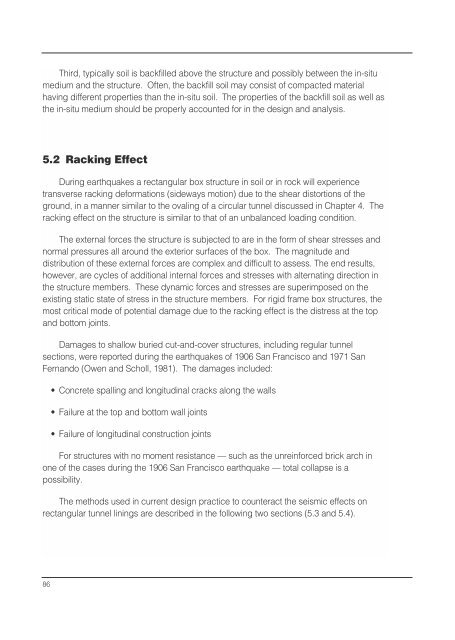Seismic Design of Tunnels - Parsons Brinckerhoff
Seismic Design of Tunnels - Parsons Brinckerhoff
Seismic Design of Tunnels - Parsons Brinckerhoff
Create successful ePaper yourself
Turn your PDF publications into a flip-book with our unique Google optimized e-Paper software.
Third, typically soil is backfilled above the structure and possibly between the in-situ<br />
medium and the structure. Often, the backfill soil may consist <strong>of</strong> compacted material<br />
having different properties than the in-situ soil. The properties <strong>of</strong> the backfill soil as well as<br />
the in-situ medium should be properly accounted for in the design and analysis.<br />
5.2 Racking Effect<br />
During earthquakes a rectangular box structure in soil or in rock will experience<br />
transverse racking deformations (sideways motion) due to the shear distortions <strong>of</strong> the<br />
ground, in a manner similar to the ovaling <strong>of</strong> a circular tunnel discussed in Chapter 4. The<br />
racking effect on the structure is similar to that <strong>of</strong> an unbalanced loading condition.<br />
The external forces the structure is subjected to are in the form <strong>of</strong> shear stresses and<br />
normal pressures all around the exterior surfaces <strong>of</strong> the box. The magnitude and<br />
distribution <strong>of</strong> these external forces are complex and difficult to assess. The end results,<br />
however, are cycles <strong>of</strong> additional internal forces and stresses with alternating direction in<br />
the structure members. These dynamic forces and stresses are superimposed on the<br />
existing static state <strong>of</strong> stress in the structure members. For rigid frame box structures, the<br />
most critical mode <strong>of</strong> potential damage due to the racking effect is the distress at the top<br />
and bottom joints.<br />
Damages to shallow buried cut-and-cover structures, including regular tunnel<br />
sections, were reported during the earthquakes <strong>of</strong> 1906 San Francisco and 1971 San<br />
Fernando (Owen and Scholl, 1981). The damages included:<br />
• Concrete spalling and longitudinal cracks along the walls<br />
• Failure at the top and bottom wall joints<br />
• Failure <strong>of</strong> longitudinal construction joints<br />
For structures with no moment resistance — such as the unreinforced brick arch in<br />
one <strong>of</strong> the cases during the 1906 San Francisco earthquake — total collapse is a<br />
possibility.<br />
The methods used in current design practice to counteract the seismic effects on<br />
rectangular tunnel linings are described in the following two sections (5.3 and 5.4).<br />
86
















